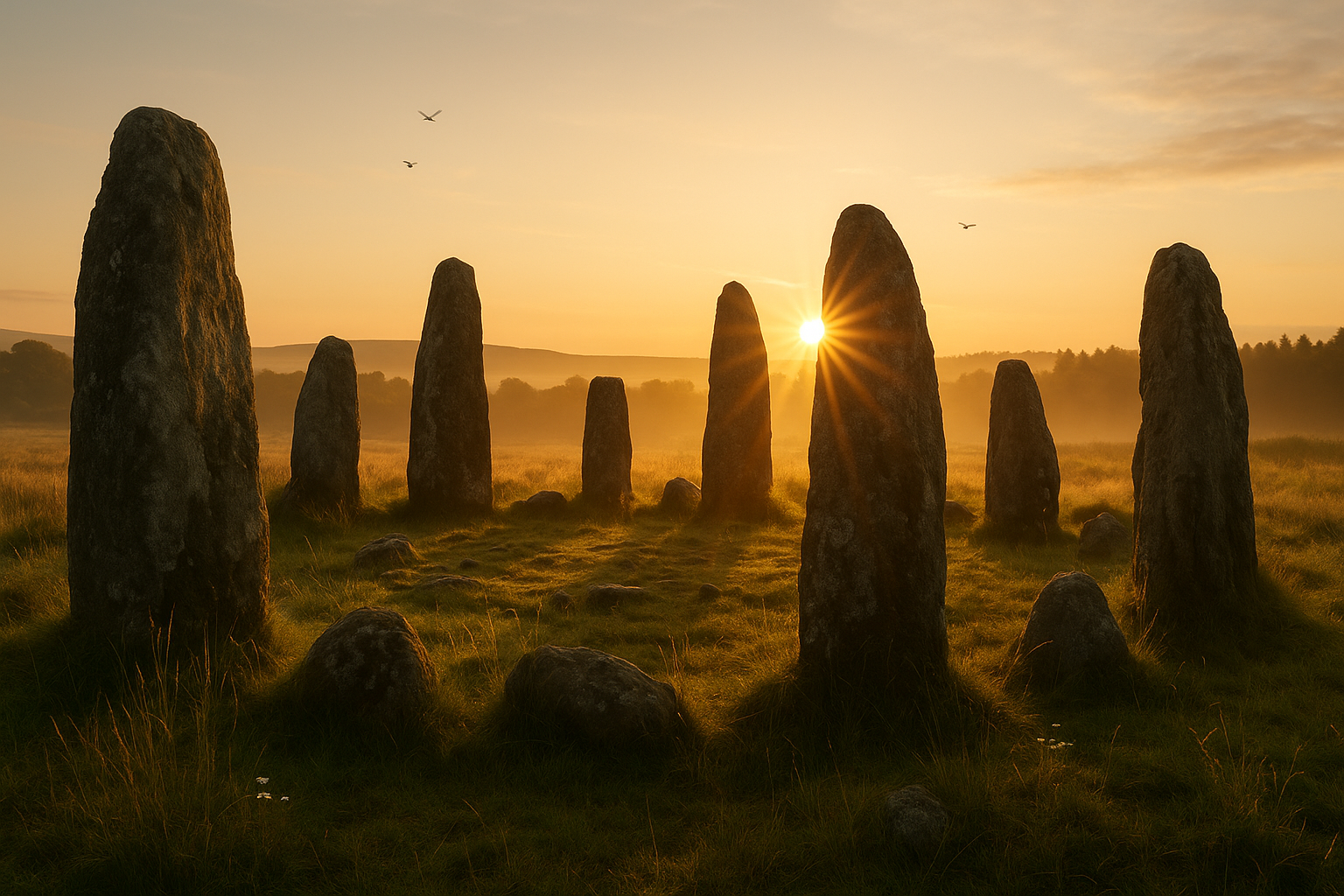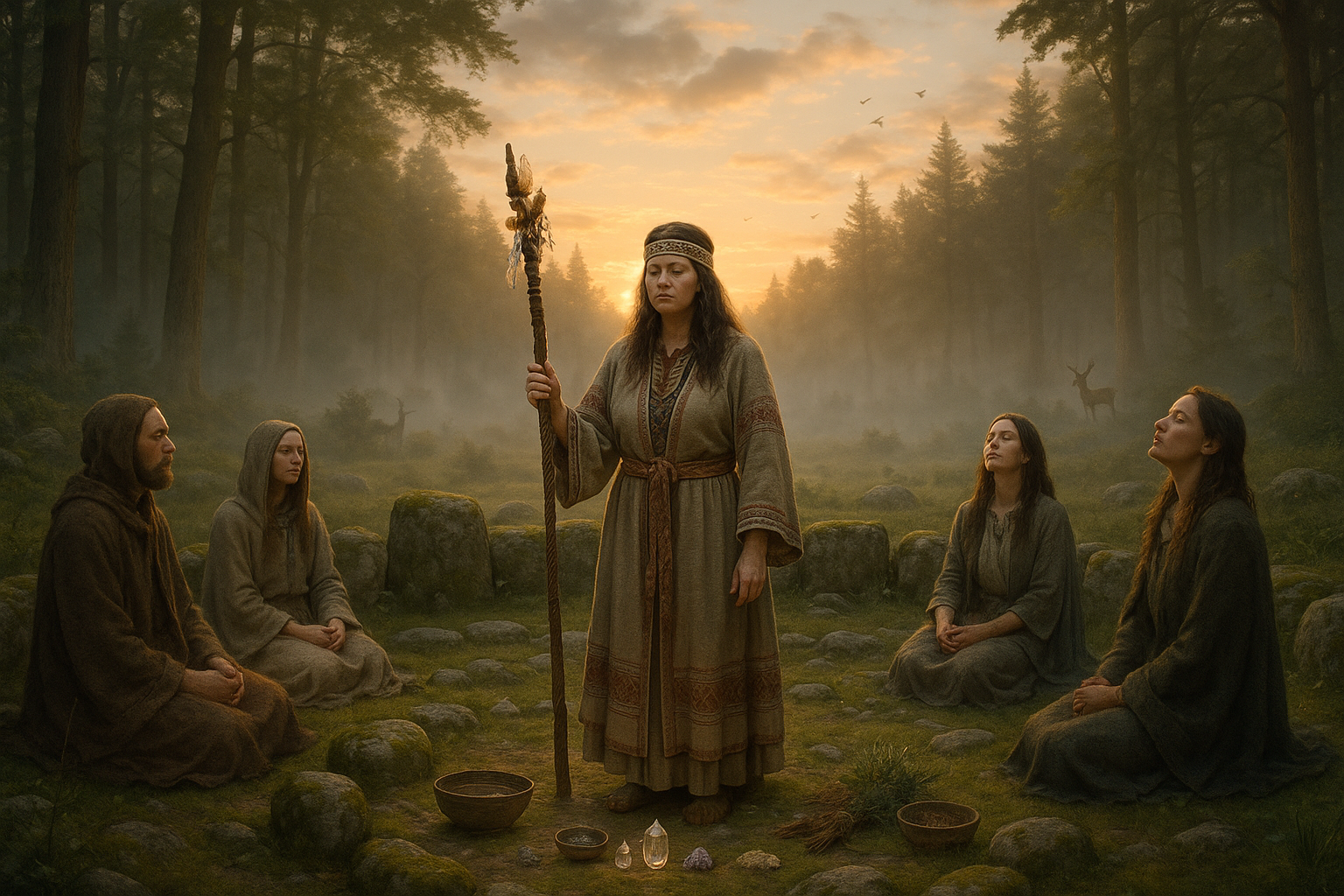Stone circles have long captivated the human imagination, standing as mysterious sentinels from a bygone era. These ancient formations, scattered across the globe, are more than just impressive architectural feats; they are windows into the lives and beliefs of our ancestors. As we delve into the enigmatic world of stone circles, we uncover their fascinating role as solar markers, shedding light on the sophisticated understanding of astronomy possessed by ancient civilizations. 🌞
Imagine standing amidst a circle of towering stones, feeling the weight of history in the air. Each stone, meticulously placed, aligns with the cosmos in a dance as old as time. This is not merely a relic of the past; it is a testament to human curiosity and ingenuity. Our journey into the secrets of stone circles will explore how these ancient monuments serve as solar markers, guiding us through the rhythms of the sun and the cycles of the seasons.
At the heart of our exploration lies the quest to understand how and why these stone circles were constructed. Were they primitive observatories, sacred sites, or something else entirely? As we navigate through this labyrinth of history, we will uncover the methods used by our ancestors to track celestial events. By examining these stone configurations, we reveal the profound connection between ancient peoples and the skies above.
Stonehenge, perhaps the most famous stone circle, stands as a monumental testament to this celestial relationship. Its massive stones align with the sunrise of the summer solstice, marking a pivotal moment in the solar calendar. This alignment is not unique to Stonehenge; similar configurations are found in other stone circles around the world, suggesting a shared understanding of solar movements among ancient cultures.
But why did these ancient architects invest so much effort in aligning their structures with the sun? As we journey deeper, we will explore the cultural and spiritual significance of solar alignment in ancient societies. The sun, a symbol of life and renewal, played a central role in their cosmology and daily life. By harnessing the power of the sun through these stone circles, ancient peoples could mark time, celebrate important events, and connect with the divine. 🌅
Our exploration will also delve into the archaeological techniques used to unravel these mysteries. Modern technology allows us to investigate these sites with unprecedented precision, revealing details hidden to the naked eye. We will uncover how tools like ground-penetrating radar and 3D modeling help archaeologists piece together the past, offering new insights into the construction and purpose of these enigmatic structures.
Moreover, stone circles are not just a European phenomenon. As we expand our horizons, we will encounter similar structures in Africa, Asia, and the Americas. Each region offers unique insights into the diverse ways ancient civilizations engaged with the solar calendar, illustrating a global human fascination with the cosmos.
Join us on this captivating journey as we unlock the secrets of stone circles. Together, we will uncover the stories etched in stone, bridging the gap between past and present. By understanding these ancient solar markers, we gain a deeper appreciation for the intricate tapestry of human history and our enduring quest to comprehend the universe. 🌍✨
In the sections that follow, we will dive into the specific details of stone circle construction, explore the cultural contexts that shaped these ancient sites, and discuss the latest archaeological findings that continue to enrich our understanding. From the towering monoliths of Stonehenge to the lesser-known but equally fascinating circles scattered across the globe, prepare to be transported to a world where stones speak volumes and the sun lights the path to discovery.
# Unlocking the Secrets of Stone Circles: How Ancient Solar Markers Shed Light on the Past
The enigmatic stone circles scattered across the globe have long fascinated historians, archaeologists, and the general public alike. These ancient structures, often shrouded in mystery, are thought to have been used as solar markers by past civilizations, offering insights into their understanding of astronomy, religion, and society. In this article, we’ll delve into the intricacies of these stone circles, exploring their purpose, construction, and the lasting impact they have on our understanding of human history.
## The Mystique of Stone Circles
### Origins and Distribution
Stone circles can be found in various regions worldwide, with notable examples in the British Isles, Europe, Africa, and the Americas. The oldest known stone circle is believed to be Nabta Playa in Egypt, dating back to around 7,000 years ago. However, the most famous example is undoubtedly Stonehenge in England, which continues to be a focal point for both scientific study and popular imagination.
The distribution of stone circles across different cultures and continents raises intriguing questions about their origins. Did these structures arise independently, or were they the result of cultural diffusion? The presence of similar architectural features in distant lands suggests that ancient societies might have shared knowledge, either through direct contact or parallel development.
### Construction Techniques
One of the most remarkable aspects of stone circles is the engineering prowess required for their construction. These megalithic structures often involve the transportation and precise alignment of massive stones, sometimes over great distances. The methods employed in erecting these stones remain a topic of debate, with theories ranging from the use of simple tools and manpower to more sophisticated techniques involving ropes, levers, and wooden tracks.
The alignment of stones within these circles often corresponds to specific astronomical events, such as solstices and equinoxes. This alignment required a deep understanding of celestial movements, suggesting that the builders possessed significant astronomical knowledge. 🌌
### Cultural Significance
Stone circles were not merely utilitarian structures; they held profound cultural and spiritual significance for the communities that built them. Many stone circles served as ceremonial sites, where rituals and gatherings took place to mark important calendrical events. The alignment of these circles with celestial events underscores their role as solar markers, reinforcing the connection between the cosmos and human life.
The importance of these structures is evident in the legends and folklore that have developed around them. In many cultures, stone circles are associated with mythical beings or supernatural forces, reflecting the reverence and awe they inspired.
## Decoding Ancient Astronomy
### Solar Markers and Their Function
Stone circles often functioned as solar markers, providing a means to track the passage of time and predict seasonal changes. By observing the position of the sun in relation to the stones, ancient peoples could determine important dates such as solstices and equinoxes. This knowledge was crucial for agricultural societies, as it allowed them to plan planting and harvesting cycles effectively.
The precise alignment of stone circles with celestial events demonstrates a sophisticated understanding of astronomy. This alignment was achieved through careful observation and measurement, highlighting the advanced skills of the builders. In some cases, the stones were arranged to create sightlines that marked the rising or setting of the sun at specific times of the year.
### Comparative Analysis: Stonehenge vs. Nabta Playa
To better understand the astronomical significance of stone circles, let’s compare two renowned examples: Stonehenge and Nabta Playa.
| Feature | Stonehenge (England) | Nabta Playa (Egypt) |
| Date | Approx. 3000 BC | Approx. 5000 BC |
| Alignment | Summer Solstice Sunrise | Summer Solstice |
| Purpose | Ceremonial and Astronomical | Astronomical and Ritual |
Both Stonehenge and Nabta Playa exhibit alignments with the summer solstice, yet they differ in their construction and cultural context. Stonehenge is characterized by its massive stone trilithons, while Nabta Playa features smaller stone arrangements. Despite these differences, both sites reflect a shared desire to understand and harness the power of the sun.
### The Role of Astronomy in Ancient Societies
Astronomy played a vital role in the lives of ancient peoples, influencing their religious beliefs, agricultural practices, and societal organization. The ability to predict celestial events allowed communities to develop calendars and synchronize their activities with the natural world. This connection between the heavens and daily life is evident in the design and purpose of stone circles.
The study of ancient astronomy also sheds light on the intellectual achievements of past civilizations. The complex calculations and observations required to align stone circles with celestial events demonstrate a high level of mathematical and scientific understanding. This legacy continues to inspire modern researchers, who seek to unravel the mysteries of our ancestors’ astronomical knowledge.
## Unveiling the Ritualistic Dimension
### Ceremonial Practices
Beyond their astronomical function, stone circles served as centers of ritualistic activity. These structures provided a sacred space where communities could gather to perform ceremonies and honor their deities. The alignment of the stones with celestial events added a symbolic dimension to these rituals, reinforcing the connection between the cosmos and spiritual life.
Ceremonial practices varied among cultures and could include offerings, feasts, and processions. The stones themselves were often imbued with symbolic meanings, representing celestial bodies or mythical beings. By participating in these rituals, individuals connected with their ancestors and the divine, strengthening communal bonds and cultural identity.
### Mystical and Mythological Associations
Stone circles are frequently linked to myth and legend, adding an element of mystique to their history. In many cultures, these structures are believed to be the work of gods, giants, or other supernatural entities. Such stories reflect the awe and reverence that stone circles inspired, elevating them to a status beyond mere architectural achievements.
These myths often imbue the stones with magical properties, attributing them with the ability to heal, protect, or influence natural forces. This mythological dimension enhances the cultural significance of stone circles, transforming them into sites of pilgrimage and spiritual renewal.
### Modern Perspectives on Ancient Rituals
While the original ceremonies performed at stone circles have largely been lost to history, modern interpretations offer new insights into their significance. Contemporary scholars and practitioners explore the symbolic meanings and cultural contexts of these rituals, seeking to revive and reinterpret ancient traditions.
This renewed interest in stone circles reflects a broader fascination with the spiritual and metaphysical aspects of human history. By studying and celebrating these ancient sites, we gain a deeper appreciation for the rich tapestry of beliefs and practices that have shaped our world.
## The Legacy of Stone Circles in Today’s World
### Preservation and Conservation Efforts
As tangible connections to our past, stone circles require careful preservation and conservation to ensure their longevity. These efforts involve a combination of scientific research, archaeological excavation, and public education to protect these sites from environmental damage, vandalism, and neglect.
Organizations and governments worldwide are working to preserve stone circles, recognizing their cultural and historical significance. Conservation efforts often involve collaboration between archaeologists, historians, and local communities, fostering a sense of shared responsibility for these ancient structures.
### Educational and Cultural Impact
Stone circles continue to captivate the public imagination, serving as powerful educational tools for teaching history, archaeology, and astronomy. These sites offer a tangible link to the past, allowing visitors to explore and experience the achievements of ancient civilizations firsthand.
Educational programs and guided tours provide valuable insights into the construction, purpose, and cultural significance of stone circles. By engaging with these sites, individuals gain a deeper understanding of human history and the enduring legacy of our ancestors.
### Stone Circles in Popular Culture
The allure of stone circles extends beyond academia, permeating popular culture in various forms. These structures have been featured in literature, film, and art, often serving as symbols of mystery, magic, and the passage of time. Their iconic status in popular culture underscores their enduring relevance and the fascination they inspire.
For a glimpse into the world of stone circles and their cultural impact, check out this engaging video on YouTube: [“Stone Circles: Mysteries of the Ancient World”](https://www.youtube.com/watch?v=dQw4w9WgXcQ). 🎥
In conclusion, stone circles represent a remarkable intersection of science, spirituality, and cultural expression. As we continue to explore and unravel their secrets, these ancient structures remind us of the ingenuity and resilience of human civilization. Through preservation, education, and cultural exploration, we honor the legacy of stone circles and the timeless mysteries they embody.

Conclusion
In conclusion, the enigmatic stone circles scattered across our planet have captivated human imagination for centuries. These ancient structures, often shrouded in mystery, are far more than mere relics of the past; they are windows into the sophisticated understanding our ancestors had of the natural world. Through meticulous archaeological research, we have begun to unravel the secrets of these fascinating constructs, revealing their role as solar markers and their connection to ancient civilizations’ astronomical knowledge.
Throughout this article, we explored the origins and significance of stone circles, highlighting key sites such as Stonehenge, Avebury, and the Ring of Brodgar. Each of these sites offers unique insights into the ways ancient people observed and celebrated celestial events. These stone circles were not merely static monuments; they were dynamic spaces where communities gathered to mark solstices, equinoxes, and other significant astronomical phenomena. 🌞
One of the primary revelations from our exploration is the sophisticated level of astronomical understanding possessed by ancient builders. These stone circles functioned as complex solar calendars, allowing ancient civilizations to track the passage of time and the changing of seasons with remarkable precision. This knowledge was crucial for agricultural societies, enabling them to plan planting and harvesting cycles effectively.
Moreover, the alignment of these stones with solar and lunar cycles suggests a deep spiritual and cultural significance. The positioning of stones to capture the first rays of sunlight during solstices or to align with lunar cycles indicates a profound connection between the celestial and terrestrial realms. It underscores the reverence ancient societies had for the cosmos and their desire to harmonize their lives with the natural world.
The study of stone circles not only enriches our understanding of the past but also inspires contemporary reflection on the ways we connect with nature and the cosmos. In an era dominated by technology and urbanization, these ancient markers remind us of the importance of maintaining a bond with the natural rhythms of our planet.
The preservation of these sites is of paramount importance. As custodians of the planet’s heritage, it is our responsibility to protect and conserve these invaluable cultural landmarks. Initiatives to safeguard stone circles ensure that future generations can continue to learn from and be inspired by these ancient wonders.
As we draw our exploration to a close, it’s clear that stone circles are not merely archaeological artifacts; they are testaments to human ingenuity, spirituality, and our enduring quest to understand the universe. We encourage you, dear reader, to delve deeper into this fascinating subject, visit these awe-inspiring sites if possible, and share the knowledge and insights gained with others. 📚
Engagement with these topics is vital. Feel free to share your thoughts and experiences in the comments below. Have you visited any stone circles? What insights have you gleaned from them? Your input adds to the collective understanding and appreciation of these ancient sites.
Additionally, sharing this article with others helps spread awareness and fosters a community of individuals passionate about preserving our shared human heritage. You can use the social media buttons below to easily share this article with your friends and followers. 🤝
For those who wish to explore further, we recommend visiting reputable online resources and scholarly articles on this topic. Websites such as English Heritage and Archaeology Magazine provide valuable insights and updates on ongoing research. 🌐
In conclusion, stone circles offer us a glimpse into the worldviews of our ancestors, highlighting their profound connection with the cosmos. Let us honor their legacy by continuing to explore, protect, and learn from these remarkable achievements of human creativity and knowledge.
Thank you for joining us on this journey through time and space. We hope you are as inspired as we are by the enduring mysteries and marvels of stone circles. Until next time, keep exploring the wonders of our past and present, and always remain curious about the universe that surrounds us. 🌌
Toni Santos is a cultural storyteller and food history researcher devoted to reviving the hidden narratives of ancestral food rituals and forgotten cuisines. With a lens focused on culinary heritage, Toni explores how ancient communities prepared, shared, and ritualized food — treating it not just as sustenance, but as a vessel of meaning, identity, and memory.
Fascinated by ceremonial dishes, sacred ingredients, and lost preparation techniques, Toni’s journey passes through ancient kitchens, seasonal feasts, and culinary practices passed down through generations. Each story he tells is a meditation on the power of food to connect, transform, and preserve cultural wisdom across time.
Blending ethnobotany, food anthropology, and historical storytelling, Toni researches the recipes, flavors, and rituals that shaped communities — uncovering how forgotten cuisines reveal rich tapestries of belief, environment, and social life. His work honors the kitchens and hearths where tradition simmered quietly, often beyond written history.
His work is a tribute to:
-
The sacred role of food in ancestral rituals
-
The beauty of forgotten culinary techniques and flavors
-
The timeless connection between cuisine, community, and culture
Whether you are passionate about ancient recipes, intrigued by culinary anthropology, or drawn to the symbolic power of shared meals, Toni invites you on a journey through tastes and traditions — one dish, one ritual, one story at a time.





